Blog
CATEGORY: Email and social are more than just friends
Email and social are more than just friends
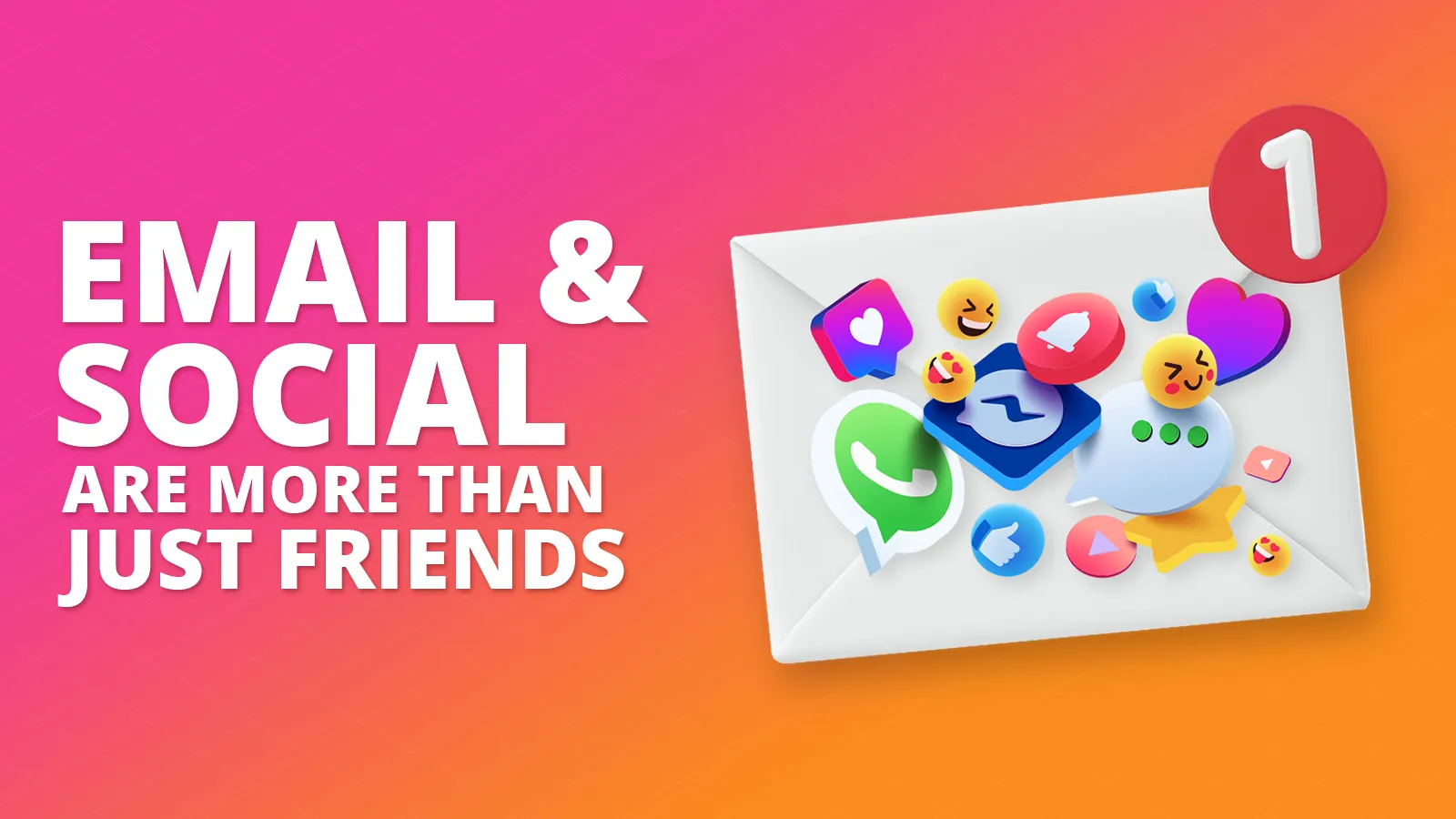
“E-mail - in digital communication terms - is an ancient and often under-utilised channel, but it’s clear that it remains a stubbornly popular communication means for many of our audiences. At its worst, it’s a newsletter on an out-of-date template with poor accessibility. At its best, it’s a responsive, intelligent and accessible means to boost campaigns and deliver measurable outcomes. What this session revealed is that when paired with your social content, the potential results are that much greater.”
At the LGComms Next Generation Digital event held in Sheffield recently, our email expert Dan Hare had the opportunity to share his thoughts on how social can influence email, and vice versa, and why they should be considered in parallel and partnership as, when these two powerhouses work together, success is inevitable.
Many thanks to Zander Mills both for inviting us along to share in the discussion and for his comments above.
Below is a summary of the information we shared at the event, and I hope that you find it as useful as the attendees did.
An ever-changing pot
You know the marketing mix is an ever-changing pot and, as members of the DMA, we look at their market research quite carefully. And year after year in their consumer e-mail tracker, they tell us that email is the preferred channel of over 70% of consumers across the journey. So, for communicators, e-mail has to be the preferred weapon of choice.
We have seen more recently social become equally popular to e-mail and the 18 to 24 bracket, so that's why today is really about looking at how the two work well together and to remind everyone that e-mail can be a huge driver of attention and interest in your social profiles, and social can be a great way to build your database of direct contact and engagement.
For example, the new platform that seems to be getting a lot of public sector attention at the moment is a network called “Nextdoor”. I was a little bit curious about it a while ago, so signed up to yet another social network. And then yes, my only real interaction with next door for certainly the first few weeks was them emailing me relentlessly, every day, with updates as to what was going on, on the platform itself.
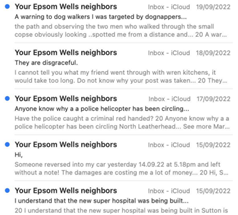
And this is a tried and tested methodology that pretty much all the social networks have employed nowadays. Obviously, you see things like push notifications for apps being equally important to these tools, but effectively they are driving attention and interest in their platform.
Engagement and ENGAGEMENT
Using e-mail and indeed where I live down in deepest, darkest Surrey, our local MP Chris Grayling uses e-shot to send out his emails but he also uses Nextdoor to pretty much disseminate the same information across the two channels.
I was interested to see when I looked at the stats in terms of the attention and interest he was generating on Nextdoor, 22 people engaging with his content, but then I took a look at his email statistics.
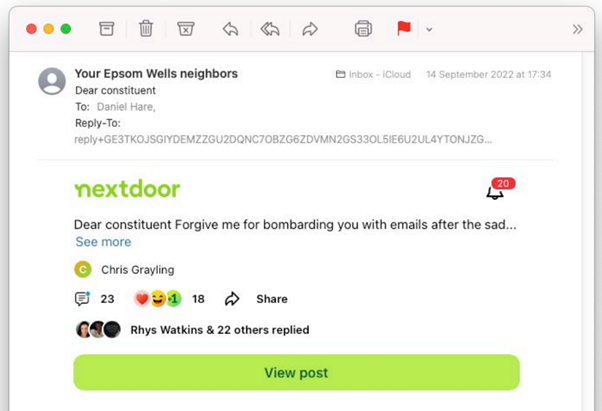
He's got an audience of about 18,000 people via our e-mail platform and 12,000 of them are regularly engaging. And what we mean by regularly engaging is they have at least interacted with one of his emails within the last 30 days.
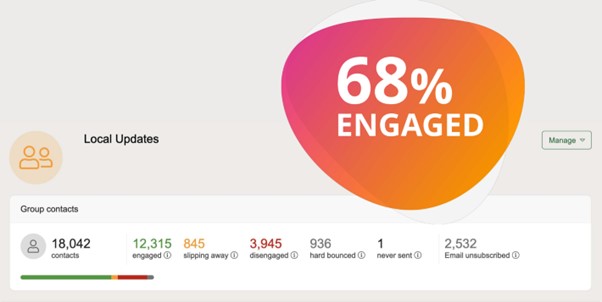
So as a method of reaching an audience, email is well established and I would not think about email versus social. I would think about e-mail and social and how the two can do.
The other thing is obviously in terms of driving traffic to social from your emails is of course the ubiquitous social icons in all of your emails on all of your microsites, on all of your web pages, and you know one of the things we tried to make sure of in e-shot is we keep on top of those things. So, rather than the kind of the Facebook logo from 2009, they are all dynamically updated on the platform, because these things do change.
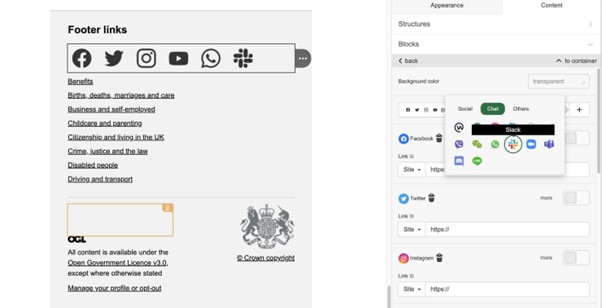
And indeed, we find nowadays, there is a much more diverse selection of channels as well. So, for those using social tools in a business-to-business capacity, there are channels like Teams and Slack to also think about.
What I see in an awful lot of emails is the kind of links to either follow or indeed share content on social or that they are a bit of an afterthought, hidden away down in the footer. Think about the types of content that you're sharing via e-mail, if it's stuff which is perfect for social, then don't be afraid to put those buttons encouraging people to share, right up there with the articles.
Time to think square
Next thing we'll look at is taking aspects of social into your emails, as there is an awful lot of innovation in the social space. But there's just a couple of fundamental design principles which you know, we've seen work well in social, and they also work well in e-mail, the first of which is square images.
We watch email design, both through our platform and through research in the wider marketplace and we are still seeing emails that have been solely designed for desktop and yet for many years now, the majority of people read emails on mobile devices. That creates a situation where it's difficult, because on a mobile device, portrait images work better and on a desktop, landscape images work better.
But the Instagram happy medium actually works really well in any channel. So, in terms of square images, what's good for the goose is good for the gander and we see that one of our customers.
For example, one of our customers is Essex County Council; they have the 'Love Essex' brand for their recycling communications. On the left there, you've got an article from their e-mail on the right an article from their Instagram and you'll see there the square images.
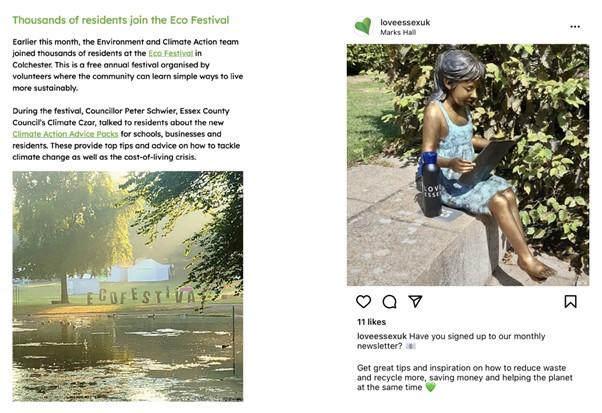
Less is more
But there's another thing which I would recommend for e-mail that you take a lesson from social, which is to be succinct and to the point. We still see an awful lot of e-mail designs with war and peace, too much content, too much copy. People scan emails, in just the same way as they scan social posts/feeds.
You've really got to get to a point where they are scanning and finding meeting meaning from, you know, interesting headlines and minimalist copy as opposed to trying to cram too much into e-mail. Social obviously restricts you, most of the social profiles make it very difficult for you to have reams and reams of copy, whereas e-mail technically doesn't put those restrictions on you. But I would suggest that you take a leaf out of your social book and apply a less is more approach to how much information you put in your emails.
And Action….
Another lesson we can learn from social is the popularity of video.
As we talked about, think about e-mail or social as communication channels to drive attention and interest in content. So as a very effective form of content in social, video has really proven its worth and yet there's still a resistance to use video in e-mail and it's perfectly acceptable to do so. Support of video natively in e-mail clients is still pretty sketchy and that's why we do things cleverly nowadays so that you can embed a video in your e-mail, and if the device that it's being shown on will support it, the video will play in the e-mail, and if it doesn't, it just links out to YouTube.
Socially accessible
My next tip is to make your social profiles accessible. We've done an awful lot of work over the last couple of years with the likes of the Equality and Human Rights Commission to understand and apply accessibility, best practices to emails, and we've looked at that from the social perspective as well. It's quite surprising just how easy it is to trip up.
For example, we talked before about the ubiquitous social icons within your e-mail designs. What often happens in terms of emails and indeed on websites, if you take the default set of social profile links and which give you an eclectic mix of colours to choose from, representing each of the brand colours for those for those social networks.
However, this does create a number of accessibility issues for those with certain learning difficulties. Just the overwhelming amount of colour is enough to confuse them. It's not something, when they look at, they can necessarily process because it's so much going on there.
But the other thing is when we one of the one of the key pitfalls that we try to avoid, is making sure things have a sufficiently decent contrast ratio. And what I mean by that is the smaller things are, the more contrast they have to have.
If you want to understand how things look to those with sight issues, then the best thing is to make everything mono, because that will give you the best steer as to what works and what doesn't in terms of contrast, it's also very easy to check these things scientifically with various online tools.
For example, if we just add background colour to some of these social icons, as you see there or the top row there, the blue ones, you know Facebook and LinkedIn are effectively lost, they become inaccessible just by having a background colour. Likewise with WhatsApp, on the on the 3rd row has the same issue when a green background is applied.
Not so much from an accessibility perspective, but just from the from the perspective of good design in e-mail, is we also have to accommodate things like dark mode.
Nowadays people use dark mode on their phones and awful lot, and indeed an awful lot of devices late at night will switch to dark mode automatically, so your set of black icons on a white background all of a sudden disappear completely when the e-mail is put into dark mode, so that creates an accessibility issue for everybody.
So just have a look at how your icons are being displayed within your emails and within your other channels, and make sure they're accessible because obviously you want to drive people to these profiles. But if they can't actually see it or understand it, then obviously you fall at the first hurdle.
Encourage social use of your content
Obviously, your main social profiles will be useful to you and highly effective. I have no doubt, but obviously what you really need to do is encourage engagement with your content within your communities. So, it's not about what you say about yourself, it's what about others say about before you and you see an increasing number of central government campaigns, certainly leveraging that.
For instance, I picked up on the fact that Sheffield, where we are today, recently promoted the cycle to work/ cycle to school week, the "Bikeability Scheme" on their Facebook page, which is great.
But they did something quite clever too, as that social posts drives people to a microsite and on that microsite you will find a form.
And in that form, they suggest that they will e-mail you some exciting social media images to share your "cycle to school week pledge" online. So obviously it's one thing for you to put your own content on social, but it's quite another when you can encourage citizens to share your content and to some extent you can guide them and channel them in terms of the conversation.
So again, e-mail is a great way to achieve that, for example by putting together a simple e-mail which contains a toolkit. Give some advice and information of how to get involved in your initiatives, both from the perspective of the real world aspect, but also how to actually ensure that they are taking part in the conversation online.
So just think about that the next time you're planning a campaign. How could e-mail help in terms of actually driving more attention than interest on social, not through anything on your own social profiles, but that on the profiles of your potential audience.
A lot of people tend to just think of e-mail as newsletters and it's so much more diverse than that, and that's where we really come on to the final point, which is probably the most complicated, complex, but also the most important, which is combining e-mail and social in the journey.
Combine email and social in the journey
We do some work for the Home Office. They've been running a big campaign for the last couple of years to recruit 20,000 new police officers and you will see a multi channel approach to that task at the begin with the end in mind.
The objective here is to generate. You see is to get 20,000 new police officers. The objective here is not to increase engagement in our newsletter. It's not to get more followers on Instagram. There is a real world purpose behind this campaign and then they use e-mail and social and TV and the whole range of mediums. The traditional marketing mix to drive attention and interest in the opportunity to become a police officer. This is one of their Instagram posts.
And indeed, what we then do is take that journey further, because an awful lot of time social posts have to be relatively generic in nature, whereas what you're then able to do if you can affect a smooth handover from social to e-mail is you can then get more granular.
You can get more specific. So in this particular example, those who look to sign up are encouraged to choose the police forces that they're interested in joining,
and that in turn drives quite a sophisticated automation machine, whereby emails are sent, which are pretty, pretty personalized to the individuals in question and indeed personalized to the choices that they have made. So if you're not interested in a particular police force, you don't get emails about it, obviously.
So where there is a generic campaign from a social perspective that then able to drive people down the journey towards, ultimately fulfilling the action that they want them to by providing more targeted content from an e-mail perspective.
And they doing pretty well on that campaign, still got a fair way to run about 13,790 extra police recruited so far, so over halfway.
Email is more than just a newsletter
The trick with this is to look at the maturity of your e-mail program, think about how it can work with your other channels and enhance the effectiveness to combining their benefits. Use the broad reach of social together with the pinpoint accuracy of email. But what I suggest, what I would like you to consider as well when you are planning out your social comms is where e-mail could fit into those ideas as well and look beyond the basics of doing newsletters.
We talk more about this in our article about the email maturity model.
Solutions
Email marketing healthcheck
We are confident that we can help you, which is why we offer a free healthcheck to identify potential issues with your current programme and free advice on things that could be done to improve it.

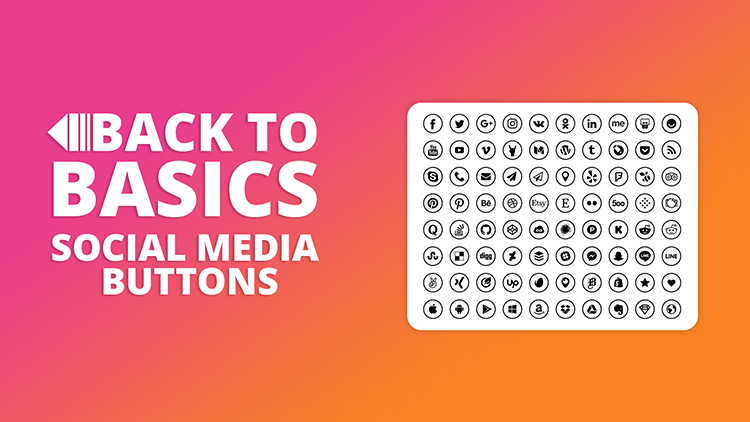
.jpg)